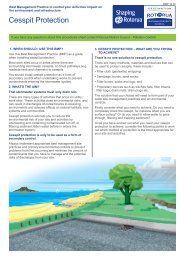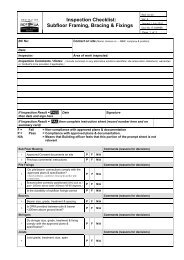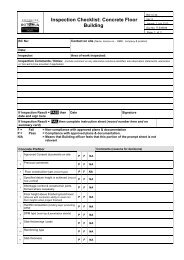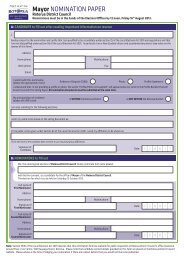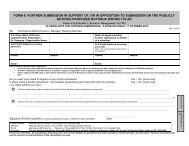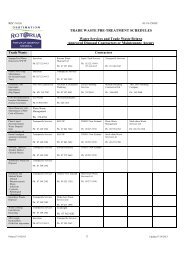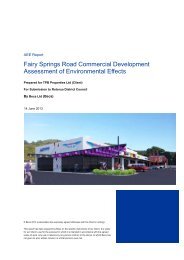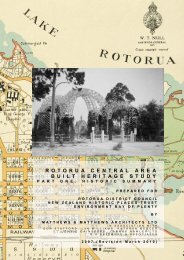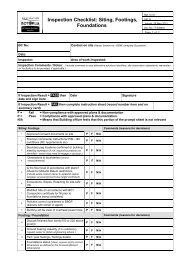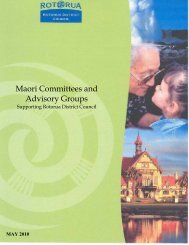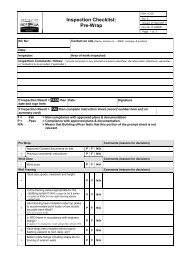COUNCIL OVERVIEW - Rotorua District Council
COUNCIL OVERVIEW - Rotorua District Council
COUNCIL OVERVIEW - Rotorua District Council
Create successful ePaper yourself
Turn your PDF publications into a flip-book with our unique Google optimized e-Paper software.
<strong>COUNCIL</strong> <strong>OVERVIEW</strong>3Message from the Mayor andChief Executive5 Direction setting 2013/149 Major issues/improvements 2013/1416 Capital works programme - urban18 Capital works programme – ruralLake <strong>Rotorua</strong>2 <strong>Rotorua</strong> <strong>District</strong> <strong>Council</strong> ANNUAL PLAN 2013/14
Message from the Mayor and ChiefExecutiveTena koutou katoa.<strong>Rotorua</strong> <strong>District</strong> <strong>Council</strong> chief executive, Peter Guerin (left)and <strong>Rotorua</strong> Mayor, Kevin WintersIn 2008, as the world reeled from the sudden jolt ofthe Global Financial Crisis, there was every reasonto anticipate that things would return to normal ina year or two. As we all know now, that proved notto be the case.Today, five years on, <strong>Rotorua</strong> <strong>District</strong> <strong>Council</strong> hasbecome accustomed to the complex andchallenging balancing act of delivering highquality services to our community in anenvironment of decreasing available funding inreal terms and rising operational costs - while atthe same time endeavouring to hold ratesincreases to an absolute minimum without cuttingservice levels.In this Annual Plan for the 2013/14 year we showthat for the fifth year in a row we are signalling oneof the lowest overall rates increases of any councilin the country – less than 1 percent.The overall amount of general rates we propose tocollect will be only 0.99% more than last year - lessthan official inflation estimates of 1.2% for thecoming year, and substantially below the 3.5%rates increase signalled last year in the Long-termPlan. This means <strong>Rotorua</strong> <strong>District</strong> <strong>Council</strong> rates willhave increased, on average, less than 2% for eachof the last five years. The actual impact on eachrating sector will vary from the 0.99% overall ratesincrease across all sectors. The impact on thebusiness sector will be a decrease of 0.20%, andincreases for rural residential of 1.40%, urbanresidential of 1.02% and farming of 2.20%.In achieving another sub-inflation rates increase inthis plan we have been very conscious that there isno will from our residents for service levels to bereduced to match funding limitations. Indeedthere are substantial community demands for thecouncil to spend significantly more on someactivities, in particular those that will help stimulatethe local economy.We can reassure residents that the economy willremain a focus of our attention in the coming year,in line with the three overarching themes of ourLong-term Plan. These themes - economicprosperity, environmental improvement andcontinuous business improvement - are reinforcedin this year’s Annual Plan.Maintaining a vibrant CBD is a vital element ofeconomic prosperity for our city and a raft of newmeasures in this plan will help achieve that. As partof revitalising our central city area we willinvestigate a new time-based free parking regimereplacing meters and ‘pay & display’ units withnew ‘Smart Eye’ technology linked to our parkingenforcement team.We are also establishing a new Inner CityEnterprises (ICE) unit integrating on-the-ground cityservices with the CBD revitalisation programme,and working in partnership with CBD stakeholders.This unit will draw together the planning,development and implementation of CBDrevitalisation projects alongside operations formaintaining the CBD, under one managementstructure. This unit will include Safe City Guardians,Economic Projects and our Castlecorp CBDcleaning and maintenance team.One of the proposals for development this year isthe introduction of trial ‘Smart eye technology’ toprovide designated areas of time-limited freeparking in the CBD. This follows the trial of ‘freeparking’ in the lead up to Christmas 2012. Theresults of that trial showed that there was a strongdemand for a more robust and clearly definedparking regime to attract more people back intothe CBD and create a greater flow of traffic in andaround retail stores and other businesses.<strong>Rotorua</strong> <strong>District</strong> <strong>Council</strong> ANNUAL PLAN 2013/14 3
Message from the Mayor and ChiefExecutive cont.Following testing of the technology it is anticipatedthat by December, following a parking policyreview, this new technology will be fully installedand operational. The annual estimated cost of theICE programme operations including time-limitedfree parking is $400,000 per annum.<strong>Rotorua</strong> International Airport remains another keyelement of our city’s economic future. Three milliondollars has been included in council budgets overthe next two years ($1 million in 2013/14 and$2 million in 2014/15) to continue supporting jointventure marketing with airlines in the key overseasvisitor market of Australia. The council will alsocontinue allocating $4 million per annum to serviceloans related to airport infrastructural developmentundertaken in recent years. This is in keeping withthe way the council funds other key communityinfrastructure such as roads, sewerage schemesand event facilities.<strong>Council</strong> Controlled Organisation Grow <strong>Rotorua</strong> Ltdis now fully operational and will play anincreasingly important role alongside partnerorganisations to help achieve the specificobjectives of the <strong>Rotorua</strong> Sustainable EconomicGrowth Strategy. Funding of $800,000 is includedwithin the ICE activity budgets for Grow <strong>Rotorua</strong>this coming year.Over the next two years the council will be takingits proposed <strong>District</strong> Plan through the criticalphases of notification and appeals with a view tothe plan becoming operative in 2014/15. The<strong>District</strong> Plan is the foundation for all land usedecisions ensuring sustainable management of thedistrict’s natural and physical resources. It identifieswhere activities can take place, what land can bedeveloped, requirements to be met before anychange in use or development, and what naturalor cultural features need to be considered.<strong>Rotorua</strong> <strong>District</strong> <strong>Council</strong> has been awarded agovernment grant of $4.7 million to build a fullscale waste treatment plant using the worldleadingTERAX technology developed by Scion inpartnership with the council. This will providesignificant economic and environmental benefitsto <strong>Rotorua</strong> <strong>District</strong> <strong>Council</strong> in the long term. A newcompany, TERAX Ltd, is jointly owned by the twoorganisations and will take on responsibility for NewZealand-wide and international commercialisationof the TERAX process.Programme partners – Te Arawa Lakes Trust, Bay ofPlenty Regional <strong>Council</strong> and the Crown – to thiseffect, and we will be focussing on a number ofwaste water treatment enhancements during theyear. For more information on lakes programmesvisit www.rotorualakes.co.nz.Conservative and prudent management of debtwill continue to ensure debt levels remain withinmanageable parameters and below maximumsset by council policy. Debt levels are programmedto commence a pattern of continual reductionfrom the 2018/19 year.As we aspire to be the best local authority in thecountry, customer service continues to be aconstant focus of our attention. We have achallenging and on-going array of enhancementsunderway that will further boost customer serviceacross the organisation, regardless of whethercustomers contact us in-person, by phone, byemail or online. We are currently working inpartnership with Hamilton City <strong>Council</strong> to increasethe number of areas where <strong>Rotorua</strong> residents canconduct business with us online, 24 hours a day,seven days a week. ‘Dogs Online,’ enablingresidents to register their dogs without having tocome into the council, is one such programmealready successfully operating via our website.‘Lean Thinking’ is an international business conceptwhich is being progressively implementedthroughout the operations of the council and isalready changing the way we conduct much ofour council business. The Lean Thinking programmeis aimed at continuous improvement andincreased efficiencies to deliver more value to ourcustomers. It involves council teams workingtogether to review operational systems, increaseflexibility, reduce wastage, provide moreinnovation and find creative solutions to problems.The momentum built up in the last year from LeanThinking will be maintained in the 2013/14 year.This introduction to the 2013/14 Annual Plantouches on only a selection of the plan’scomponents. We encourage residents to read thefull plan.Helping to improve the water quality of <strong>Rotorua</strong>’slakes remains an important priority of the council inthe coming year and reinforces our key Long-termPlan theme of environmental improvement. We willcontinue to work with our <strong>Rotorua</strong> Te Arawa LakesKevin WintersMayorPeter GuerinChief Executive4 <strong>Rotorua</strong> <strong>District</strong> <strong>Council</strong> ANNUAL PLAN 2013/14
Direction setting 2013/14 cont.Three key themes<strong>Council</strong> is reinforcing its vision by delivering onthree key themes:Theme 1: Economic prosperity – investmentfocussed on the district’s economic growth as setout in the Long-term Plan.Theme 2: Environmental improvements: asustainable and targeted contribution to improvingnatural and built environments.Theme 3: Continuous business improvement: acouncil that is focussed on customer services andcontinuous productivity improvement.The three key themes help council to deliver thegoals and objectives set out in the Long-term Planand to manage costs and revenue. Lookingtowards 2013/14 <strong>Council</strong> has reflected on thethemes and has carefully considered the impactsand projects associated with them. This ensuresthat the direction of council’s delivery of servicesand costs remains in line with the intent of theLong-term Plan. <strong>Council</strong> has outlined in thefollowing sections (major issues/projects 2013/14)how the goals and objectives of the three keythemes will drive strategies, plans, projectimplementation and customer service delivery.Financial strategyAs part of the Long-term Plan 2012-2022 <strong>Council</strong>developed a financial strategy. The financialstrategy is both an overall direction for financialmatters and a synthesis of the financial issues andconsequences of council policies and servicedelivery decisions. It tells our community what willbe provided and how much it will cost, taking intoaccount pressures and demands from competingwants and needs of the community. In planning itsbusiness, the council must undertake a balancingact of delivering services while keeping fundingaffordable, ensuring equity between current andfuture generations, fairly sharing the costs ofdelivering services across different users andmaintaining a strong balance sheet. In <strong>Council</strong>’sfinancial strategy 2012-2022, five drivers of financialmanagement were identified. Theyacknowledged an initial focus on economicprosperity and development, a subsequent returnto a balance across all four wellbeings, the needfor effective cost controls to achieve low ratesincreases (i.e. less than 3.5% for years 1-3),managing debt in a prudent financial manner andpreserving levels of service.<strong>Council</strong> has tested this financial strategy and is ofthe view that the drivers of the financial strategycontinue to be the priorities despite some minorchanges developing out of Local GovernmentReform. Economic prosperity continues to be amajor focus for the council as seen in thecommitment to Grow <strong>Rotorua</strong> Ltd, joint venturemarketing with airlines and continuation of theCBD revitalisation programme. The four wellbeingshave been removed from the definition oflocal government functions. However <strong>Council</strong>believes that the functions and activities itundertakes continue to meet the new purpose oflocal government.Delivering the lowest possible rates increases is anongoing commitment. The financial strategyworked on the assumption that rates increaseswould be held to less than 3.5% for years 1-3 of theLong-term Plan. This annual plan proposes a smallrate increase of 0.99% for the 2013/14 year. This isachievable while still delivering the same servicespreviously provided. Being more efficient,reducing waste and enhancing customer serviceshas provided the catalyst to achieve this.Financial strategy1. Focus on economic prosperity2. Return to sustainable balance across the wellbeings3. Rates increase less than 3.5% in years 1-34. Retain/improve service levels5. Ten year debt below policy limits<strong>Council</strong> debt/Debt reductionSubmissions to the draft Annual Plan from residents,business people and elected members includedconcern about the level of debt being proposed.This has led to questions being raised about the useof debt for council growth and increased levels ofservice capital expenditure. <strong>Council</strong> closelymonitors debt levels, particularly debt in ten yearstime. This is to ensure that debt levels are alwaysmanaged within prudent debt managementpolicy and to retain ‘head room’ in the last threeyears of the Long-term Plan for future generationsto use that capacity for their aspirations.However as a result of community concern aboutthe level of debt, <strong>Council</strong> has agreed to establisha debt reduction programme. This may include anumber of tools such as:• Strategic property reviews – review of strategicproperty to identify where council is holdingproperty that may no longer be required andcould be disposed of.• Rate rises – targeting rate rises which would bedirectly put towards lowering the debt.• Levels of service review – undertaking reviewsof services provided by <strong>Council</strong> to establish ifthere are opportunities to reduce the level ofservice without significant change in servicesprovided. If this is undertaken, a full6 <strong>Rotorua</strong> <strong>District</strong> <strong>Council</strong> ANNUAL PLAN 2013/14
Direction setting 2013/14 cont.programme of consultation would be requiredto ensure council fully understandsexpectations around the services provided.The overall objective would be to allow <strong>Council</strong>to either defer expenditure or make savingsthat can be used to repay debt.• Capital works programmes – for capitalexpenditure related to “new” growth and levelsof service projects establish a framework toassess capital projects, fully evaluating costs,return to council, impacts on borrowing, need,ability to enter into joint venture funding etc.These will test the need, timing and funding ofprojects that require large amounts ofborrowing to proceed.<strong>Council</strong> has set a goal of $2 million revenue fromthe sale of property within the 2013/14 year forreduction of debt. Other debt reduction goals willbe developed in line with <strong>Council</strong> decisions onwhat level of debt reduction is appropriate givencommunity concerns.The reduced debt level now forecast ascompared to the Long-term Plan is also the resultof a number of capital projects not proceeding aspreviously planned for the 2013/14 year in theLong-term Plan. These include:• Sewerage schemes not proceeding due toconsenting issues (Rotoma, Gisborne Point,Hinehopu)• Deletion of lighting project for <strong>Rotorua</strong> Museum• Deferring development of a health centre atthe Aquatic Centre• Deferral of Kuirau Park development• Deferring initial development of a publictransport centre due to lack of NZTA supportAt the time this Annual Plan was adopted debtforecast for 30 June 2013 was $159.40 million. Overthe life of the 2013/14 Annual Plan this is forecast torise to $168.00 million (this reflects $2 million of debtrepayment from property sales) at 30 June 2014.Long-term Plan projecteddebt ($ in thousands)2012/13 2013/14Long-term Plan 2012-2022 158,114 172,781Annual Plan 2013/14 debt159,400 168,001estimate estimateContinuous business improvement – LeanThinkingThe <strong>Council</strong> is progressively implementing a boldprogramme of increased efficiencies andcontinuous improvement based on the successfulinternational business concept known as ‘LeanThinking.’ Under Lean Thinking, staff members areencouraged to bring more flexibility to their work,to be innovative, and to find creative solutions toproblems, so the expectations of customers arebetter met. Within the first year, Lean Thinkingdelivered a number of improvements to ourorganisation including improved service tocustomers, recognition from our peers in otherlocal authorities and the private sector, nationalawards and financial savings. Throughout the2013/14 year we will maintain this momentum bycontinuing to better understand and meet ourcustomers’ needs and recognising what theyvalue, while focussing on reducing waste ofresources.Refocus council’s maintenance andoperations business unit - CastlecorpIn line with the new purpose of Local Government,the council has examined how it uses andmanages its operational service arm, Castlecorp.<strong>Council</strong> has refreshed its business model to betterreflect the partnership relationship that exists, withthe aim of improving overall efficiency,effectiveness and economy of services providedby Castlecorp to the organisation.This builds on similar reviews in the past. In 2009 areview of Castlecorp’s activities was undertakenby consultants, Management Toolbox. This reviewidentified a number of improvement areas,including increasing the scope of the Castlecorprange of services. Savings of close to $800,000were made at that time.In today’s operating environment the quasiseparateapproach (treating Castlecorp like aseparate contractor) leads to:• a considerable amount of duplication (quotes,and invoicing);• an adversarial relationship at times within<strong>Council</strong>; and consequently• increased costs.The main point is that Castlecorp is not like anyother contractor. It is a department of council anduses staff who are employed by council. Thereforeit is sensible to treat Castlecorp as a partner andnot a contractor. <strong>Council</strong> has now assigned morecosts previously ring-fenced to Castlecorp, to theactivity areas that directly use those staff and incurthose costs.No changes in leadership, management or its staffare anticipated for Castlecorp. The talent, skillsand experience developed at Castlecorp willcontinue to be vital to ensure efficiency andeffectiveness in its operations and activities.<strong>Rotorua</strong> <strong>District</strong> <strong>Council</strong> ANNUAL PLAN 2013/14 7
Direction setting 2013/14 cont.Rating framework / Rates for 2013/14The 2012/13 rating year saw major shifts in theincidence of rates as a result of the change tocapital value rating and the 2011 revaluation. Itmeant significant decreases for the farming sectorand slight increases for the rural residential sector.Because of changes resulting from the introductionof capital value, <strong>Council</strong> decided to have oneyear free from more major changes to the ratingsystem and to focus the 2013/14 year on thebusiness rate differential. However <strong>Council</strong> remainscommitted to its intentions as set out in the LongtermPlan 2012-2022 to:• consult on a fixed charge for holiday homesand other home businesses as a contribution tothe Business and Economic DevelopmentTargeted Rate.• moving all differentials to 1.0 over time throughthe annual plan process.<strong>Council</strong> has confirmed an overall rate rise for2013/14 of 0.99%. This includes a $4 per property(GST excl) increase in the cost of refuse collectionfor rural and urban areas. In addition, there is a $1(GST excl) increase in the targeted rate to fund theLakes Community Board. The 0.99% rate increaseis well below that signalled for year 2 of the LongtermPlan, to reflect the drop in inflation and CPI.It has been particularly challenging for the mayorand councillors to determine exactly what levelthe business differential should be moved to for2013/14. While the rates increase is to be held to0.99% overall, there was some concern thatmoving the business differential down would resultin higher rates increases for other sectors of thecommunity, such as the urban residential, ruralresidential and farming sectors. In particular thereis sensitivity to the current plight of the farmingcommunity and the impacts they are sufferingfrom the recent drought, as well as to the situationfaced by the business sector from the on-goingeffects of the global financial environment.<strong>Council</strong> confirmed its intention to adjust thebusiness differential down from 2.2 to 2.1 in the2013/14 year. This would mean the actual ratesincrease for each sector would vary slightly fromthe overall 0.99% increase in rates across allsectors. The average changes for individual ratingsectors therefore in this Annual Plan are:Other changes include minor downwardadjustments to capital contribution targeted ratesfor completed sewerage schemes.Local Government Funding Agency<strong>Rotorua</strong> <strong>District</strong> <strong>Council</strong> joined the LocalGovernment Funding Agency (LGFA) in February2013 and currently has sourced $20m of fundingthrough this agency.By joining the LGFA the council has significantlyenhanced certainty of access to debt markets, atlower interest rates than would otherwise beavailable. This is due to the LGFA’s strong creditrating (AA+) being in line with the New Zealandsovereign rating. Through the LGFA, <strong>Council</strong> alsohas access to longer term borrowings.The LGFA only lends to local authorities and eachparticipating council must adhere to a number offinancial undertakings. For example, “net debt” isnot to exceed 175% of “total revenue”. Eachcouncil must also provide a charge over rates tosecure their debt and/or guarantee obligations tothe LGFA.There is currently no history of default by a localauthority but if a council were to default a receiverappointed by the LGFA could assess and collectsufficient rates in that district or region to eventuallyrecover the defaulted payments.LGFA has a range of internal and foundationpolicies to protect and minimise risks of default anda liquidity standby facility with the NZ DebtManagement Office of $500m, in addition toparticipating councils’ guarantee obligations. Theguarantee is a contingent liability shared byparticipating councils to LGFA and is on a pro-ratabasis based on annual rates income.<strong>Council</strong> does not currently have a shareholdinginterest in LGFA.Currently 30 councils have joined LGFA asShareholder/Guarantor Local Authorities andeight, including <strong>Rotorua</strong> <strong>District</strong> <strong>Council</strong>, asBorrower/Guarantor Local Authorities.• Overall rates increase across all sectors+0.99%• Business sector (decrease) -0.20%• Rural residential sector 1.40%• Urban residential sector 1.02%• Farming sector 2.20%8 <strong>Rotorua</strong> <strong>District</strong> <strong>Council</strong> ANNUAL PLAN 2013/14
Major issues/improvements 2013/14CBD revitalisation investment program -Urban Design Framework<strong>Council</strong> is committed to continuing revitalisation ofthe central city through implementation of theCBD revitalisation project which commenced in2007 and led to the subsequent Urban DesignFramework adopted in 2011. The framework isbased on an activity precinct approach wheredistinctive areas within the city centre have beenidentified for improvement.A number of projects form part of the CBDrevitalisation programme these include:• ‘Walkable City’ – this project follows on from‘way-finding’ signage that has been erectedthroughout the city during the 2012/13 year.Tutanekai Street intersections will be altered toenable better pedestrian crossing, a redesignof seating areas and greater use oflandscaping to define the street.• On-street time-limited CBD parking regime –Installation of ‘a SmartEye’ vehicle detectionsensor system in combination with a newparking regime to attract more people backinto the CBD and create a greater flow oftraffic in and around retail and offices.Following testing of the technology, and areview of the parking policy, it is anticipatedthat by December this new technology will befully installed and operational. Annual costs of$400,000 per year have been included tosupport the concept of time-limited parkingand ICE programme operations.• ICE department - creation of a newdepartment that integrates on-the-ground cityservice functions with the CBD revitalisationprogramme. The function of this departmentwill be to plan and implement CBD projectsalongside the operations of maintaining the citycentre including the safe city guardians, streetcleaning, security camera network and theactivities of the parking wardens.• Local transport centre – investigating thelocation of a local transport centre and linkswith the regional bus network.• Eat Streat –continuing to develop a destinationwithin Tutanekai Street that attracts people andprovides a sense of arrival and alfresco diningthat is safe, inviting and commercially viable.Construction will commence in August and isexpected to be completed by December 2013.• Lakefront development – working towards adefined development concept with Lakefrontland owners and Lakefront business operators.Due to the scale of this project it is expected totake two years for the completion ofconsultation with all parties and thedevelopment of a defined concept.<strong>Rotorua</strong> International Airport• Airport development fundingIn developing the Long-term Plan the councildetermined that it was prudent for rates-sourcedfunding to continue. An allocation of $4 million ineach year of the Long-term Plan 2012-2022 hasbeen re-confirmed in this plan for the 2013/14 year.The airport needs to be considered the same wayother community infrastructural assets areconsidered. Like those other assets the airport iscommunity-owned, providing a range of benefitsto residents, and is of significant strategicimportance to the district’s economic future.“Providing an airport comes at significant cost toratepayers … but failure to provide an airportcomes at an even greater cost - to our communityand to our future potential.”<strong>Rotorua</strong> <strong>District</strong> <strong>Council</strong> ANNUAL PLAN 2013/14 9
Major issues/improvements 2013/14 cont.• Joint Venture marketing for trans-Tasman airservicesGrow <strong>Rotorua</strong> Limited – council controlledorganisation (CCO)Grow <strong>Rotorua</strong> began operating in November 2012.It was established as a result of the <strong>Rotorua</strong>Sustainable Economic Growth Strategy and is 100%owned by <strong>Rotorua</strong> <strong>District</strong> <strong>Council</strong>, operating as acouncil controlled organisation (CCO). Grow<strong>Rotorua</strong> has an independent skills-based board ofsix members plus chairperson, and employs its ownchief executive and staff.The Long-term Plan 2012-2022 did not specificallysignal a joint venture marketing campaign asprevious annual plans had. With the recentwithdrawal of flights from Hamilton to Brisbane anda new <strong>Rotorua</strong> Airport chief executive, thecommitment to tourism is at an all time high. It isnow seen as time to grow the business. It tookvisionary leadership by the council to decide tofund airport development eight years ago; nowthe vision is being focused on development of newbusiness opportunities. To be really serious aboutthe council’s vision for growing the business councilhave agreed to commit funds of up to $3 millionover two years within the Economic Developmentactivity to provide for joint venture marketing.Structuring this funding will be finalised betweencouncil and the airport company in due course. Inthe meantime <strong>Council</strong> has retained $1 million inthe 2013/14 budget and included up to $2 millionfor the 2014/15 Annual Plan.<strong>District</strong> PlanThe next two years will be a critical time for<strong>Rotorua</strong> as the council takes the new <strong>District</strong> Planthrough the notification and appeals phases withthe aim of it becoming operative in the 2014/15year. This is one of the most important documents<strong>Council</strong> has as it defines what people can do ontheir land as permitted activities or through aresource consent, and what their neighbours cando. <strong>Council</strong> notified the <strong>District</strong> Plan in October2012 with a submission period that closed 1 March2013. At closing 516 submissions had beenreceived. Over July submitters will be given theopportunity to present their submissions in person tocouncil.Grow <strong>Rotorua</strong> was created to bring a professionalinvestment approach to the understanding anddevelopment of initiatives to strengthen <strong>Rotorua</strong>’svalue proposition in its four key economic driverareas: forest industry, tourism, agriculture andgeothermal (main opportunity area). Grow<strong>Rotorua</strong> has recently released its statement ofintent (2013-2015) which unveiled its plan to be acatalyst for growth. The focus for the next year ison projects where there are synergies acrosssectors, to maximise growth opportunities. Theprojects range from growing tourism through thespa and wellness sector, to increasinginfrastructure and events for mountain biking, andusing geothermal resources in direct heatapplications. In each project work will beundertaken next year to determine growthpotential, analyse barriers and investmentopportunities, and identify potential investors.2013-2015 Grow <strong>Rotorua</strong> economic growthprojects:• Spa & wellness – grow the spa and wellnesssector across a range of facilities.• Biking – grow tourism revenue throughopportunities for biking infrastructure, servicesand events.• Processed timber – identify market segmentsand distribution channels to process and supplyproducts from pine.• Specialist living – investigate opportunities foraged care and specialist living, utilisinggeothermal resources and wood.• Innovation Park – assist in development of anInnovation Centre.• Geothermal – identify alternative uses andvalues of geothermal resources.• Geothermal direct heat – provide strategy oneconomics for utilising geothermal in directheat applications.• Manuka honey – determine opportunities formanuka honey.• Land use change – research on alternative landuses in conjunction with <strong>Rotorua</strong> Te ArawaLakes Programme.• Te Arawa investment – engage with Te Arawaand develops iwi investment opportunities.10 <strong>Rotorua</strong> <strong>District</strong> <strong>Council</strong> ANNUAL PLAN 2013/14
Major issues/improvements 2013/14 cont.• Centres of Excellence – work with tertiary andresearch institutions to determine feasibility ofCentres of Excellence in <strong>Rotorua</strong>.• Start-up facilitation – establish programmes tocreate a start-up community, provide abusiness incubation framework and developangel investor network.• Business retention and attraction – targetbusinesses that would gain real value from relocatingto <strong>Rotorua</strong>.• Investment capital – build confidentialdatabase of companies for capital investment.For more information visit the Grow <strong>Rotorua</strong> sectionof the RDC website.Famously <strong>Rotorua</strong> Campaign –Destination <strong>Rotorua</strong> MarketingOur destination marketing function contributessignificantly to the <strong>Rotorua</strong> tourism sector whichmakes a 13-15% direct contribution to <strong>Rotorua</strong>’sgross domestic product and just over 20% ofemployment. At the direction of the TourismCommittee, Destination <strong>Rotorua</strong> Marketing hasfacilitated development of a significant “gamechanging” <strong>Rotorua</strong> branding and marketingcampaign based around the brand Famously<strong>Rotorua</strong>. This campaign is domestically focussed inAuckland, Waikato and Bay of Plenty as well as alarge focus on locals of <strong>Rotorua</strong>. Its ultimate aim isto create 70,000 resident ambassadors. Acampaign such as this is budgeted to cost around$1.5 million to $2 million. In order to make a realimpact in Year One a goal of raising $1 million to$1.5 million has been set. <strong>Council</strong>’s commitment toprovide additional one-off funding towards thisproject brings the DRM contribution up toapproximately $700,000. Added to that arecommitments from the industry of $300,000. Furtherfunding is also being applied for via grants andongoing work with industry.Development ContributionsThe Development Contributions Policy wasreconfirmed by <strong>Council</strong> in adoption of the LongtermPlan 2012-2022. At present the policy is beingreviewed by central government in the suite ofpolicies/processes under review as part of thelocal government reform programme. While this isunderway council has made the decision tocontinue with the existing policy in its current formand to not undertake any further reviews until thedirection of central government is made clear onthis issue.Development contributions are a mechanism bywhich councils can secure contributions towardsthe construction of infrastructure resulting fromgrowth. With the decline of growth since theglobal economic crisis the amount expected to becollected has declined. In the 2013/14 annualplan council expects to receive around $700,000from development contributions.Fees and charges<strong>Council</strong>’s suite of regulatory fees and charges mustbe reviewed on an annual basis and the revisedfees adopted by the council. These include:Animal Control, Building Services, EnvironmentalHealth and Resource Consents. For each of thesethe fee has been increased by approximately 3%.TERAX<strong>Rotorua</strong> <strong>District</strong> <strong>Council</strong> has received a grant fromthe government of $4.7 million to build a full scalewaste treatment plant using the world-leadingTERAX technology developed by Scion inpartnership with the council. This will providesignificant economic and environmental benefitsto <strong>Rotorua</strong> <strong>District</strong> <strong>Council</strong> in the long term. A newcompany, Terax Ltd, is jointly owned by the twoorganisations and will take on responsibility for NewZealand-wide and international protection andcommercialisation of the TERAX process.Customer service – mobile solutionsPart of making it easier to interact and do businesswith the council is the opportunity to use on-lineservices through <strong>Council</strong>’s website. This is an areaof investment for the council and links to workbeing done around shared services and simplifyingcouncil processes and documentation (continuousimprovement and Lean Thinking). The council isalso focusing on enhancing customer service forthose people who choose to make contact inperson at a council location or by telephone.<strong>Council</strong> is currently working in a shared servicesarrangement with Hamilton City <strong>Council</strong> to add anumber of e-services to council’s website. This isintended to help improve customer service forresidents and reduce costs.<strong>Council</strong> is also looking to improve the effectivenessand speed of service by enhancing mobileservices where there is a good business case. Thisincludes enhancements for building inspectionsand consents, requests for service and assetmanagement information capture.<strong>Rotorua</strong> <strong>District</strong> <strong>Council</strong> ANNUAL PLAN 2013/14 11
Major issues/improvements 2013/14 cont.Staffing and staff costs<strong>Council</strong> has undertaken a major review of itsstaffing and staff costs. Within this review a moveaway from reporting only full time equivalent staffto a more transparent and understandableanalysis of budgeted staff has been introduced.Under this form of reporting all staff, be theyfulltime, part time, or fixed term are now countedin council’s overall staffing head count total andtherefore the head count matches staffingbudgets.Below are tables summarising the four operationalgroups within council to illustrate staff numbersemployed at <strong>Rotorua</strong> <strong>District</strong> <strong>Council</strong> as at 1 July2013:Corporate and Customer ServicesGroup2013/14 2012/13Community Engagement and6.00 6.50Support<strong>District</strong> Library 34.91 37.70Emergency Management 1.00 1.00Governance and Strategic DirectionChief Executive Group 5.00 5.00Corporate planning and12.00 11.80supportCorporate property 4.50 3.00Customer Centre 19.23 17.00Democracy 3.00 3.00Financial Services 24.48 24.88Human Resources 6.30 6.50Information Services 16.40 17.20Kaupapa Maori 2.00 2.00Land information services 4.00 4.00Pensioner housing 1.00 1.00Procurement and Sustainability 3.25 3.25Records 7.25 9.00Total 151.11 152.83Economic and Regulatory ServicesGroup2013/14 2012/13Building Services 17.05 16.00Economic DevelopmentCity Services operations 23.71 5.57 1Destination <strong>Rotorua</strong> Marketing 9.08 10.00Economic Projects 2.02 3.00<strong>Rotorua</strong> Visitor Centre and i-Site 19.31 19.83Events and Venues <strong>Rotorua</strong>2Convention Centre 11.85 1.75Energy Events Centre 7.24 1.00Event and community3.00 3.00programmesEvent and venues5.00 22.00administrationVenues other 1.02 1.02Planning Services 20.96 17.75Regulatory ServicesAnimal Control 8.40 8.33Inspection 9.39 9.33Parking Enforcement 6.97 6.71<strong>Rotorua</strong> Museum 27.21 20.50 3Total 172.21 145.79Infrastructure Services Group 2013/14 2012/13Aquatic Centre 31.85 31.65Engineering Services 0.00 12.57 4Asset Management 3.75 4.75Dezignworx 4.00 4.00HYDRUS 13.90 13.00Infrastructure administration 7.00 7.00Works administration 0.00 8.82Public Utilities administration 0.00 9.32Laboratory 6.00 5.00Public Gardens, Reserves and72.13 8.75 5CemeteriesCemeteries/Crematorium 2.52 0.15 5Nursery 8.40 8.55Roads and Footpaths 7.59 0.00 5Transport (road safety and2.23 2.23state highways)Sewerage and Sewage 28.85 11.89 5Stormwater and Land Drainage 8.05 0.00 5Waste Management 2.53 0.00 5Refuse collection 19.93 0.00 5Landfill 0.54 0.54Water supplies 33.28 0.00 5Total 252.55 128.22Castlecorp Group 2013/14 2012/013Castlecorp – staff cost/numbers now 0.00 119.00 5allocated across InfrastructureServices GroupFleet 3.72 3.00Total 3.72 122.00<strong>Rotorua</strong> <strong>District</strong> <strong>Council</strong> staff total 579.65 548.841Additional staff from previously external city cleaningcontracts being brought in-house and fromCastlecorp business re-focus2Redistribution of staff to align costs with mainfunctions of staff positions – overall reduction of 0.93Additional staff resulting in management of museumcafé being fulfilled by the museum and not a privatecontractor4Staff costs aligned with main functions of staffingpositions spread across Infrastructure Services Group5Staffing costs reallocated as a result of Castlecorpre-focus – alignment of staffing costs with mainfunctions of staffing positions12 <strong>Rotorua</strong> <strong>District</strong> <strong>Council</strong> ANNUAL PLAN 2013/14
Major issues/improvements 2013/14 cont.Increased emphasis on spatial planningOne frequent community comment on the draft<strong>District</strong> Plan was a request for a clear strategicdirection on how and where the district is going togrow. A spatial plan is a good way of respondingto this request and provides a simple, easy tofollow document bringing together other keytechnical documents that inform the future shapeof the district. The spatial plan will articulate likelyfuture growth scenarios for the district and willbecome a key future planning tool for <strong>Council</strong>,residents, regional council, central governmentagencies and investors. The plan will also be animportant step in ensuring the proposed new<strong>District</strong> Plan and future infrastructure investment isaligned with the growth aspirations of thecommunity.Phase 1 of the spatial plan will be completed in2013/14, in close alignment with the <strong>District</strong> Planreview process. Subsequent reviews will be linkedwith long-term planning triennial review milestonesat 2015/16 and 2018/19.It is important to emphasise it will not be “justanother plan”. Its name may yet change from‘spatial plan’ and its key function in its first phasewill be a map-focused document that reflects auser-friendly raft of technical documents.Enhanced infrastructure design –representing the character and culture of<strong>Rotorua</strong>Urban design has been evolving over the lastcouple of decades. As a result, a greateremphasis is being factored into infrastructureprojects to consider how the final structure will lookwithin the built and cultural environment. Thisapproach is recognised internationally and isdemonstrated through integration of public art,design features on solid structures, landscaping,screening etc. At an operational level a policy hasbeen developed to ensure that futureinfrastructure projects include an allowance withinbudgets to provide for the “look and feel”. Thepolicy allows for 1% of the budget to be set asidefor the aesthetic value of the project. To cementthis approach even further, an idea has been putforward to remove 1% from the overall capitalbudget and ring-fence this as a fund to ensure thatappropriate urban design is factored into projectsat the initial planning/design phase and not left tothe end of the build. The fund will sit under theresponsibility of the Community Arts Officer withinCommunity Engagement and Support. Capitalbudgets have been reduced accordinglymeaning no additional rates funding is required.Based on capital expenditure for 2013/14 this willmake available $270,000 for integration of urbandesign/infrastructure construction.Urban wastewater treatment plantThe urban wastewater treatment plant uses thelatest technology to ensure treatment of effluent isof the highest standard. It uses a Membrane BioReactor, which is technology borrowed fromdrinking water systems. The plant uses thistechnology to ensure that, to the extent possible,nutrients are stripped from the dischargedwastewater. This wastewater is then irrigated in theWhakarewarewa Forest and uses the forestry andland to further strip nutrients. However, in recentyears the consent which allows up to 40 tonnes ofnitrogen per annum has been exceeded on anumber of occasions and the Bay of PlentyRegional <strong>Council</strong> issued an Abatement Notice. Thismatter was addressed by the Environment Courtwhich requires council to apply for a variation tothe consent for the wastewater treatment plant.The process of applying for consent variation hascommenced and includes consultation withlandowners, iwi and other parties. The landowners,where council has an easement for spray irrigation,do not believe the process is sustainable into thefuture and have requested <strong>Council</strong> to explorealternatives. The alternatives are numerous andthe council is assessing a range of them. Theseinclude alternative land areas for treatment usinga range of methods not available on leaseholdland with a plantation forest, as is the currentsituation. Added to this is the need to find awastewater treatment option for a reticulatedscheme at Rotoma, Gisborne Point, etc. <strong>Council</strong>’soriginal proposal was to develop a smallwastewater treatment plant in the vicinity.However, this was appealed to the EnvironmentCourt, and the court did not support council’sproposal.A range of alternatives have been evaluated andshortlisted to two key options, one being to pipewaste to the Kawerau <strong>District</strong> <strong>Council</strong>’swastewater treatment plant and the other to pipethe effluent to the <strong>Rotorua</strong> wastewater treatmentplant. No decision has been made as yet.<strong>Council</strong> is handling the wastewater treatment planconsent variation, alternative land treatmentoptions and treatment for Rotoma/Gisborne Pointcommunity sewerage schemes as a package. Thiswill require a lot of research, technical design,consultation and various consents. It is animportant matter and one that needs to besupported by the community, landowners and iwi.Further information will be made widely availableto the community as plans are developed in orderto seek support for the particular directioneventually identified. <strong>Council</strong> remains committedto a programme towards more advanced landtreatment options.<strong>Rotorua</strong> <strong>District</strong> <strong>Council</strong> ANNUAL PLAN 2013/14 13
Major issues/improvements 2013/14 cont.Local authority shared services – BOPLASSLimitedBOPLASS Ltd is a company jointly owned by Bay ofPlenty local authorities, and was established in2008 to explore shared services. The early years ofthe company’s history were focused on using thescale of the nine local authorities to collectivelyleverage procurement gain.Local authorityBay of Plenty Regional<strong>Council</strong>Gisborne <strong>District</strong><strong>Council</strong>Kawerau <strong>District</strong><strong>Council</strong>Population2011Expenditure 2011($m)Revenue 2011($m)Staff2010277,100 76 75 28046,600 77 70 2776,940 8.5 9 57Opotiki <strong>District</strong> <strong>Council</strong> 8,950 11 11 46<strong>Rotorua</strong> <strong>District</strong><strong>Council</strong>68,900 104.5 97 522Taupo <strong>District</strong> <strong>Council</strong> 34,100 75 63.5 357Tauranga City <strong>Council</strong> 115,700 148 145 490Western BOP <strong>District</strong><strong>Council</strong>Whakatane <strong>District</strong><strong>Council</strong>45,800 63 62 16534,500 55 54 165BOPLASS Ltd has made great progress withprocurement savings over and above what couldhave been achieved individually by each localauthority. However, in many cases with thegovernment’s “all of government” tendering alsoavailable to local government, even greater gainsare possible.Therefore the company requires a step changeinto more joined-up local government in the Bay ofPlenty. A fruitful area being explored is theprovision of shared services which require two ormore of the local authorities to workcollaboratively to deliver a service jointly to thelocal authority, ratepayers and customers. Thereare effectively four approaches that can used -1. One local authority delivers the service onbehalf of a number of local authorities.2. Two or more local authorities work together tojointly deliver the services effectively.3. A separate service delivery structure such asBOPLASS delivers the services on behalf of theparticipating local authorities.4. The services are outsourced using a marketapproach and the local authority simplyprocures from that external provider.Areas being explored are back-of-house services,e.g. information technology. Other services thatare delivered to households and businesses arealso being examined. An example is the buildingconsent process. The challenge for shared servicebuilding consent activity is that the service willneed to ensure improved customer service wherecustomers are prepared to pay for that high levelof service, reduced waste and ultimately lowercosts.Some of the issues associated with such decisionsrequire:• Multiple levels of service to meet the needs ofeach participating local authority;• Understanding downstream effects on the localauthorities’ GDP, i.e. job losses or gains;• Other levels of service increasing cost reductionsufficient to create a positive benefit cost ratio.Bay of Plenty and Waikato local authorities areapplying resources and urgency to proceed inorder that gains can be realised from sharedservices for the benefit of residents and businessesof the region.Redevelopment opportunities for 20pensioner bedsits in the Rawhiti complex,Miller Street<strong>Council</strong> has 20 old and tired bedsit units in theRawhiti complex on Miller Street. As these units areno longer providing the quality of accommodationneeded for tenants, the council had included inthe Long-term Plan a budget of $3.6m to demolishthe units and replace them with modern units.Most of the rest of the Rawhiti complex wasupgraded a number of years ago with half thecost of the upgrade being covered by a HousingNew Zealand grant. There are 12 older units on thenorth end of the property which will need to beupgraded.While Housing New Zealand grants are no longeravailable to councils, RDC included $1.8 million ofexternal funding in the Long-term Plan budget toreflect some form of future partnership with a yetto-beidentified external group or body. Sincethese budgets were set, <strong>Council</strong> has beenapproached by the <strong>Rotorua</strong> Continuing Care Trustwhich operates Whare Aroha. The trust provideshospital care, short term relief and day care, andaccommodation for patients and carers. The trusthas a lease on a lakefront property that expires in2016, with a right of renewal. The trust feels it isimportant to find a new site that provides longertenure and reduced costs.14 <strong>Rotorua</strong> <strong>District</strong> <strong>Council</strong> ANNUAL PLAN 2013/14
Major issues/improvements 2013/14 cont.ProposalThe trust is interested in leasing, on a ‘peppercorn’basis, the area of the Rawhiti complex currentlyoccupied by the 20 old bedsits.The trust proposes to build a supported livingcomplex that would include 24 apartment bedsitswith a communal lounge and eating area. Thetrust would service this complex. In addition, thetrust would build a new two-storey hospital on thesite comprising 72 rooms in three connectedblocks. Beds in the hospital would be allottedfor the hospital and dementia unit as required.The council’s relationship with the trust wouldbe as a landlord (of the land) only. Theoperations and management of the complexwould remain entirely with the Trust. However, itis hoped that some additional services couldbe provided to other council tenants within theremainder of the Rawhiti complex. Anydiscussions on this would be separate to themain proposal.It is anticipated that over the next 12-24 monthsexisting tenants of the 20 bedsits will be movedinto newer units within the complex as theybecome available. The old units will then besold for removal. The <strong>Council</strong> would provide aclear site to the trust. With removal of the currentdriveway, 20 bedsit units and realignment of asewer main, the cost to council is expected to beless than $100,000.Eligibility criteria for the trust’s 24 apartments will besimilar to <strong>Council</strong>’s existing pensioner housingcriteria. On this basis, council believes there is anincrease in the overall provision ofaccommodation for pensioners within ourcommunity. <strong>Council</strong> is also supporting animportant community service and improvedservices within the remainder of the Rawhiticomplex.Changes to the draft Annual Plan<strong>Council</strong> received 176 submissions on the draftAnnual Plan. The submissions covered a broadrange of topics, including the Inner City Enterprisesproposal, Destination <strong>Rotorua</strong> Marketing, Famously<strong>Rotorua</strong> Campaign funding, Grow <strong>Rotorua</strong> Ltd,<strong>Council</strong> debt and funding of the <strong>Rotorua</strong> airport.Following careful consideration of all thesubmissions made <strong>Council</strong> made the followingdecisions:• Addition of $5,000 for additional lighting on TeAkau Road• Addition of $300,000 towards the Famously<strong>Rotorua</strong> Campaign• Addition of $50,000 towards renewal of theRotoma walkway• Removal of $1,450,000 proposed to purchase1251 Tutanekai Street (former bank building)• Continue support of joint venture fundingtowards development of additional flights,destinations and marketing of <strong>Rotorua</strong> Airportby committing up to $3,000,000 over the nexttwo years. ($1,000,000 in 2013/14; $2,000,000 in2014/15)Carry forward from 2012/13 projects notcompleted:• Lake Road - $1,300,000• Eat Streat - $394,000• Urban Design - $235,750• City Services - $200,000 for automation of carparking building• Destination <strong>Rotorua</strong> Marketing - $170,000 forrebuild of website• Waste Water - $360,000 for waste watertreatment plant renewals• Water Supplies - $20,000 for seismic valuereplacement• Water Supplies - $115,000 for urban watersupply replacements<strong>Rotorua</strong> <strong>District</strong> <strong>Council</strong> ANNUAL PLAN 2013/14 15
Capital works programme – urban16 <strong>Rotorua</strong> <strong>District</strong> <strong>Council</strong> ANNUAL PLAN 2013/14
Capital works programme – urban cont.<strong>Rotorua</strong> <strong>District</strong> <strong>Council</strong> ANNUAL PLAN 2013/14 17
Capital works programme – rural18 <strong>Rotorua</strong> <strong>District</strong> <strong>Council</strong> ANNUAL PLAN 2013/14
Capital works programme – rural cont.<strong>Rotorua</strong> <strong>District</strong> <strong>Council</strong> ANNUAL PLAN 2013/14 19



